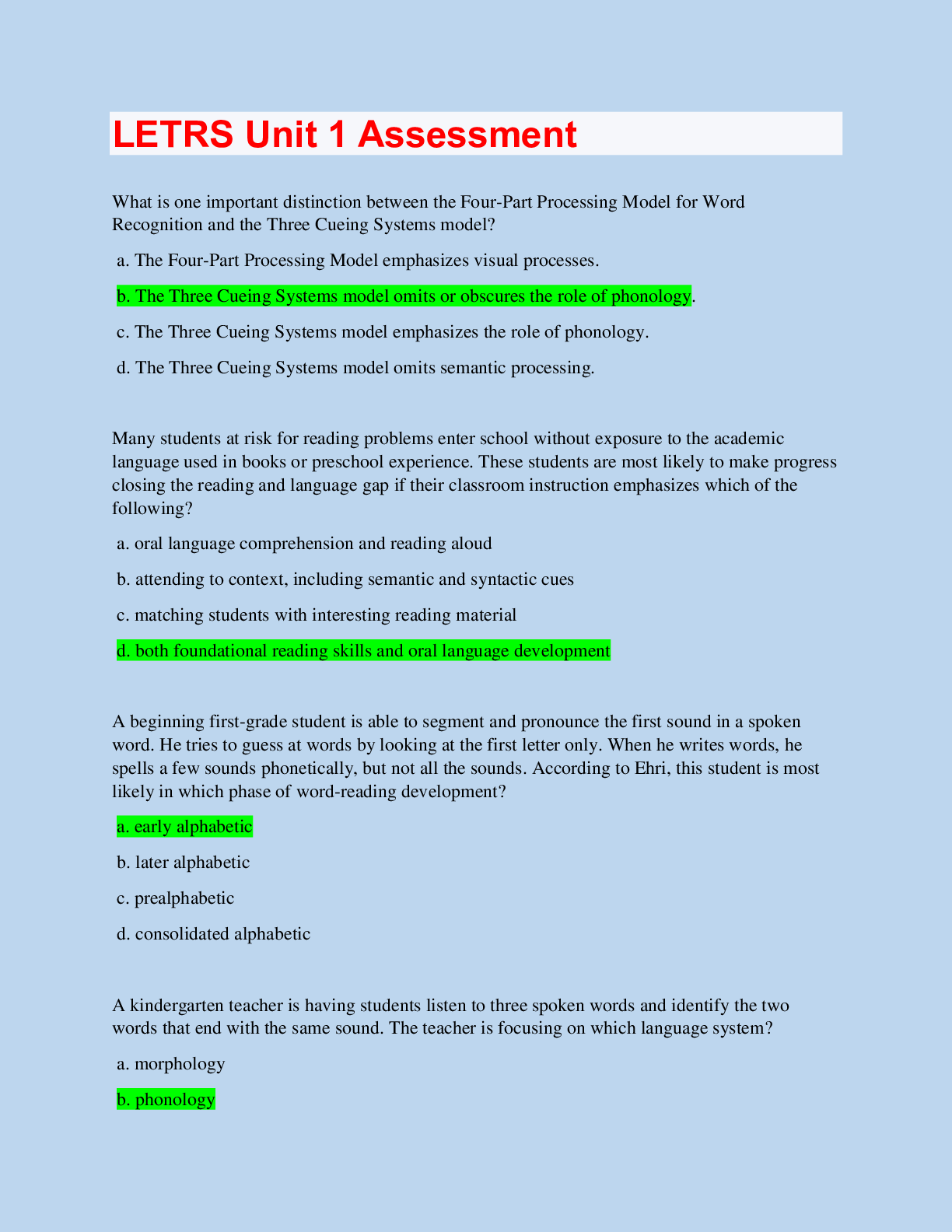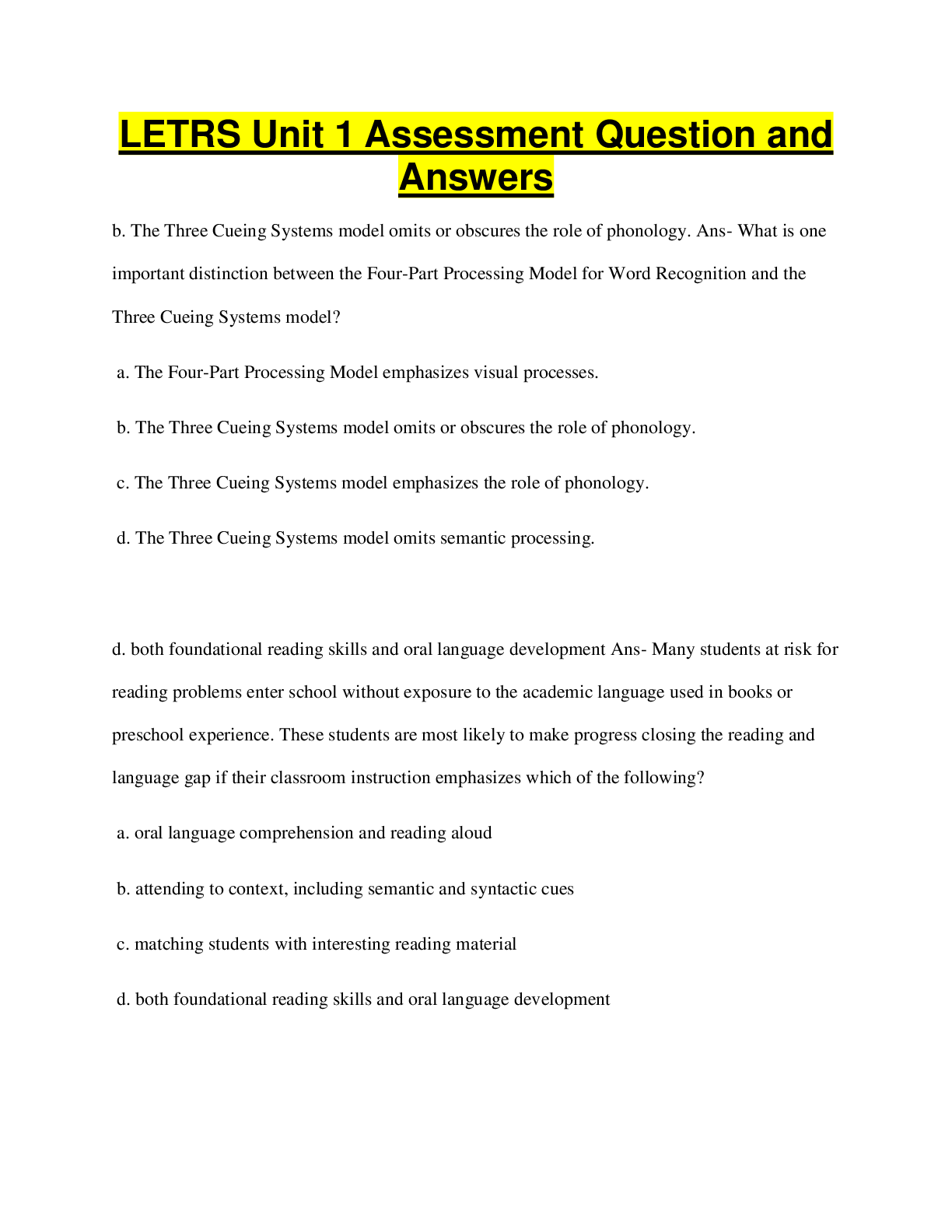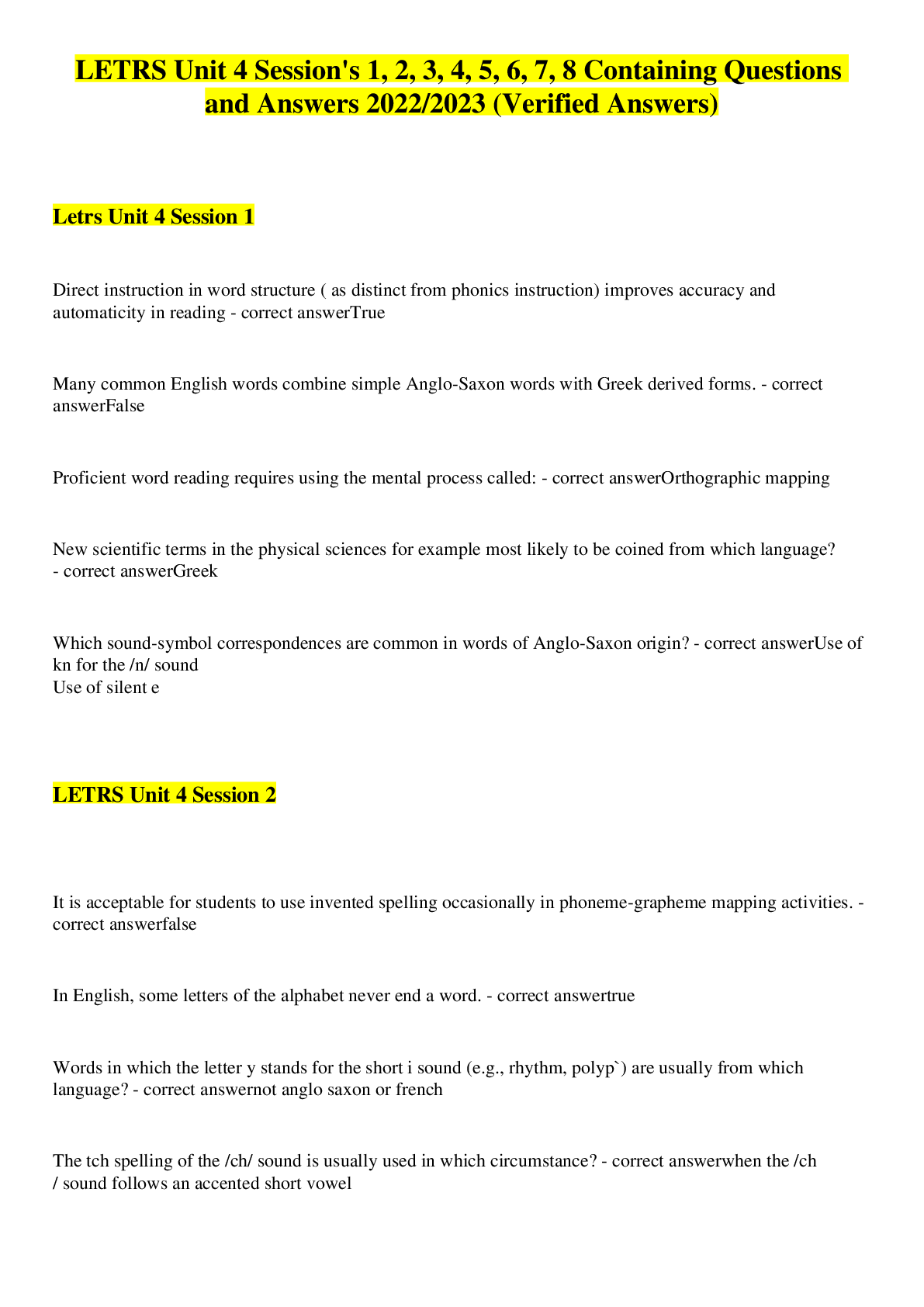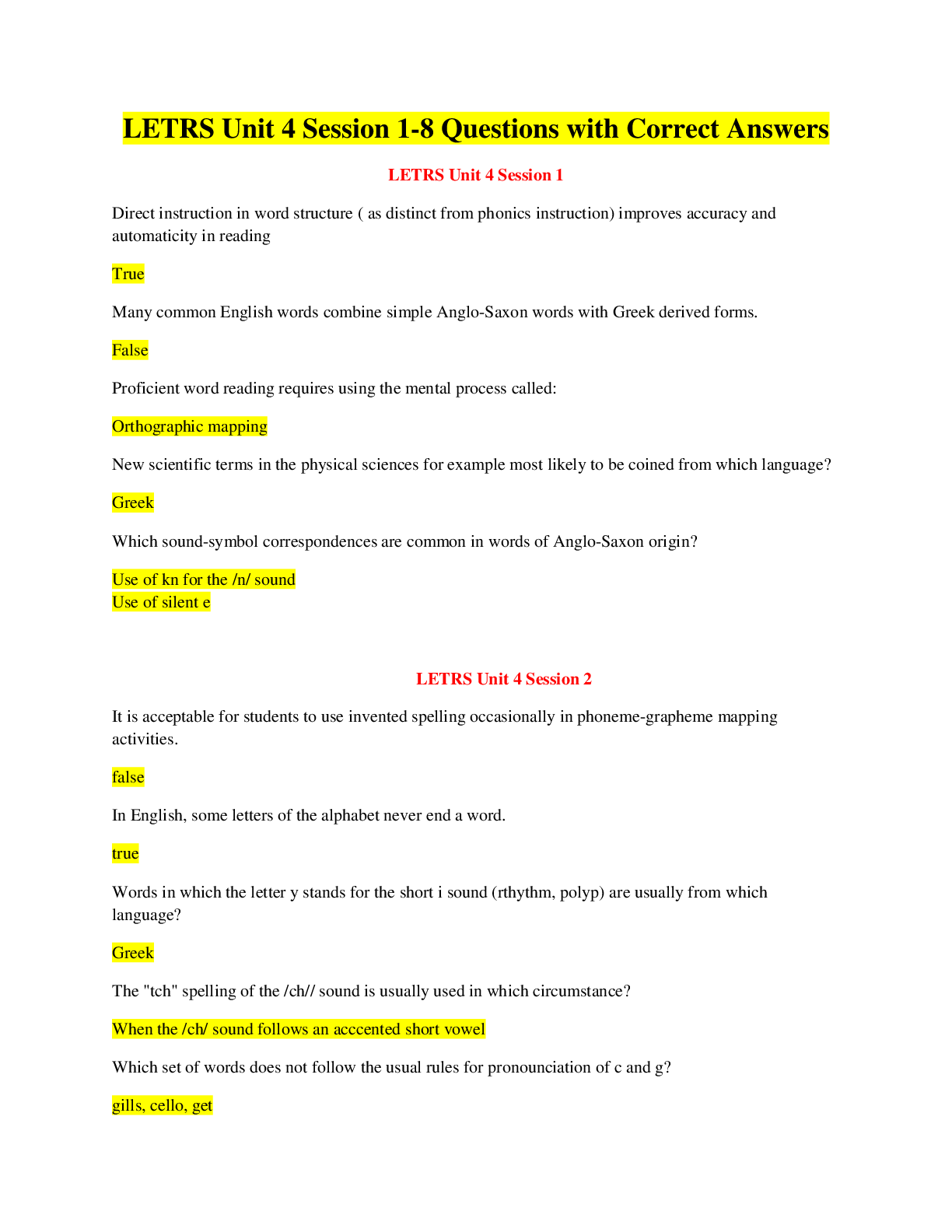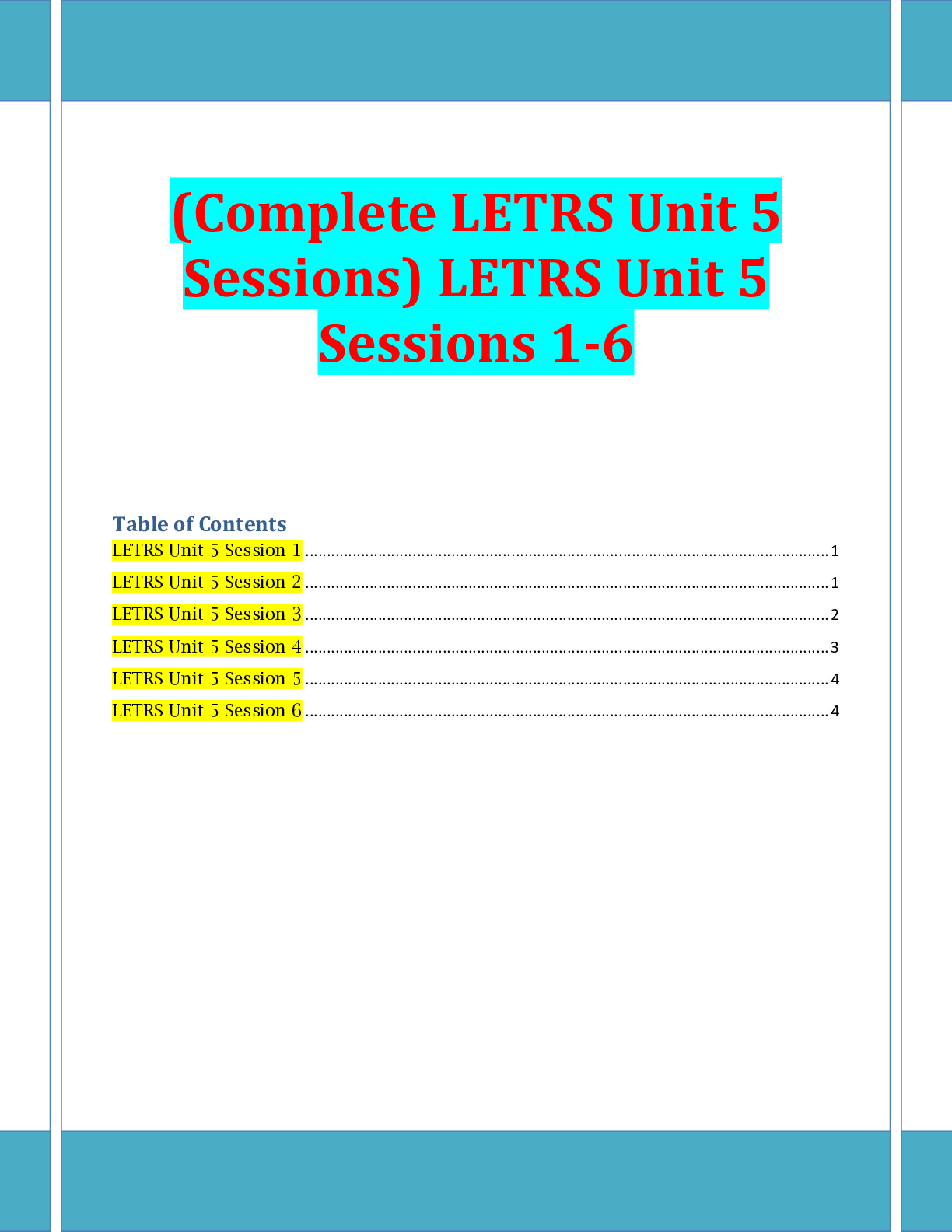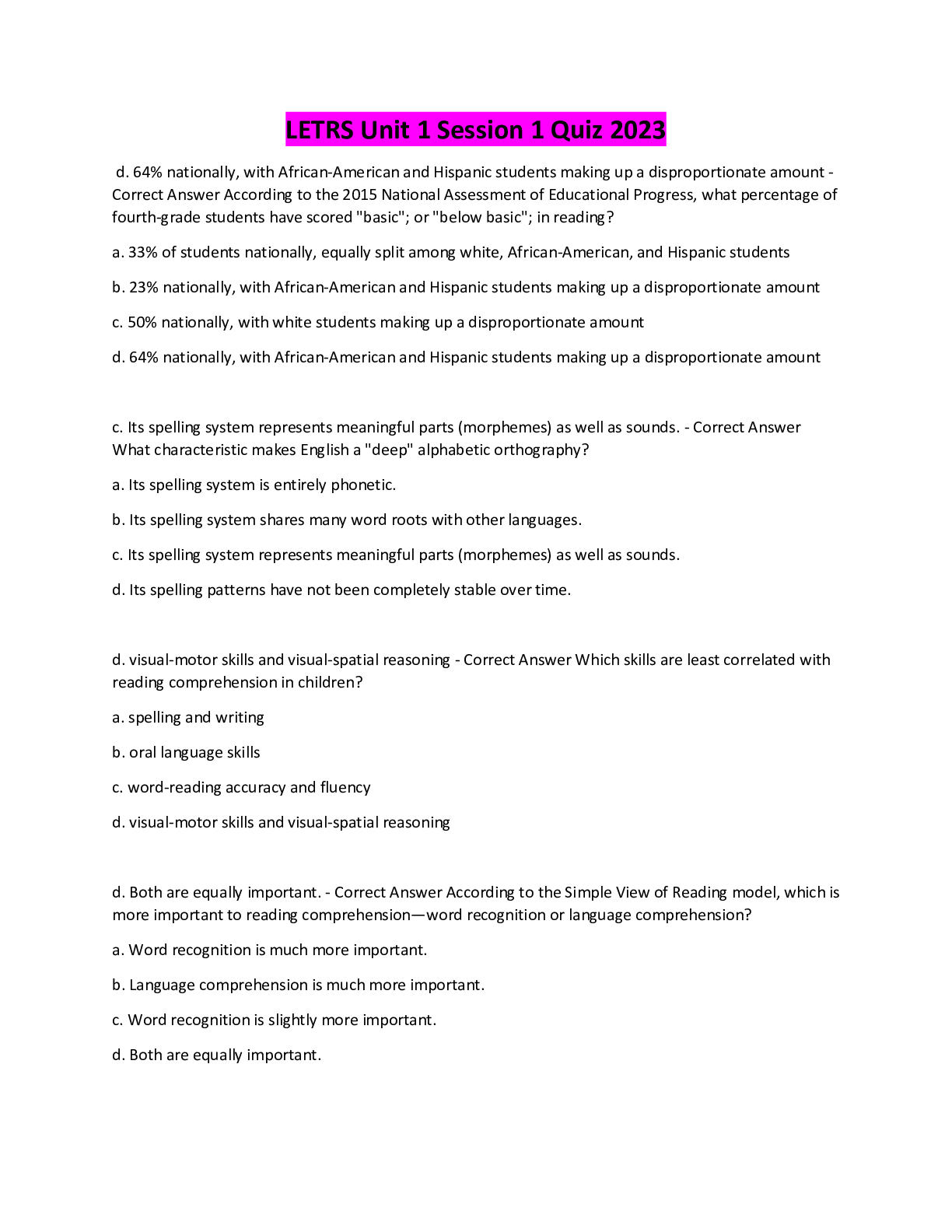*NURSING > EXAM > ATI RN MENTAL HEALTH STUDY NURSING GUIDE WITH QUESTIONS,ANSWERS AND RATIONALE{100%CORRECT AND VERIFI (All)
ATI RN MENTAL HEALTH STUDY NURSING GUIDE WITH QUESTIONS,ANSWERS AND RATIONALE{100%CORRECT AND VERIFIED}
Document Content and Description Below
ATI RN MENTAL HEALTH STUDY NURSING GUIDE WITH QUESTIONS,ANSWERS AND RATIONALE{100%CORRECT AND VERIFIED} 1. A nurse is caring for a client whose child has a terminal illness. The client requests inf... ormation about how to deal with the upcoming loss. Which of the following statements should the nurse make: a. "It will be better for you to keep busy to avoid thinking about your child's death." Encouraging the client to avoid thinking about the child's death will not allow the client to begin anticipatory grieving. b. "You will complete the grieving process about a year after your child's death." The grief process has no timeline. It varies for each individual. c. "The grief process will start once your child actually dies." The client can begin anticipatory grieving during the child's illness. d. "It is not uncommon to feel angry toward yourself or others." Feelings of blame and anger towards oneself or others are an expected reaction when a client is experiencing a loss. 2. A nurse is teaching a client who has bipolar disorder and a prescription for lithium. Which of the following instructions should the nurse include in the teaching? a. "Take this medication with food." Lithium can cause gastrointestinal distress. Therefore, this medication should be taken with food. b."Reduce sodium intake to 1,000 milligrams each day." The client should maintain an adequate and consistent sodium intake to decrease the risk for lithium toxicity. The recommended sodium intake for adults is 1,500 mg/day. c."Limit fluid intake to 1,200 milliliters each day." The client should consume 2,000 to 3,000 mL/day of fluids during initial treatment with lithium. d."Be aware that this medication can be addictive." Lithium is not classified as an addictive medication. 3. A nurse is planning care for four clients in a mental health facility. Which of the following clients is at the greatest risk for injury when performing ADLs a. A client who has severe Alzheimer's disease The greatest risk to this client is injury from performing ADLs. Clients who have severe Alzheimer's disease are typically confused, have memory difficulties, tend to wander, and need assistance to perform ADLs. b.A client who is in the maintenance phase of schizophrenia Clients who are in the maintenance phase of schizophrenia are calm and able to provide self-care with minimal risk for injury. Therefore, another client is at a greater risk for injury. C.A client who has obsessive-compulsive disorder A client who has obsessive-compulsive disorder typically performs ADLs repetitively and precisely. The client should be able to provide self-care with minimal risk for injury. Therefore, another client is at a greater risk for injury. d.A client who has dysthymic disorder Clients who have dysthymic disorder may have low energy or chronic fatigue, but they should be able to provide self-care with minimal risk for injury. Therefore, another client is at a greater risk for injury.. 4. A nurse who works with newborns is assessing the potential for abuse or neglect. Which of the following family groups should the nurse identify as the highest potential for future child abuse a. A family in which both parents are adolescents A family in which both parents are adolescents indicates a risk for the parents to become abusive toward the newborn due to lack of experience and knowledge regarding parenting. However, another family group is at a higher risk for potential abuse. b. A family in which the parents respond indifferently toward their newborn A family in which the parents act indifferently about their newborn indicates a risk for the parents to become abusive toward the newborn due to impaired bonding. However, another family group is at a higher risk for potential abuse. c. A family where one or both parents witnessed intimate partner violence in the home as children Parents who witnessed intimate partner violence as children are more likely to become abusive themselves. Therefore, this is the family group with the greatest potential for future child abuse. d. A family in which one or both parents has a developmental disability A family in which one or both parents have a developmental disability indicates a risk for the parents to become abusive toward the newborn due to difficulty learning new skills. However, another family group is at a higher risk for potential abuse. 5. A nurse is performing an admission assessment on a client and notices that the client appears withdrawn and fearful. To establish a trusting nurse-client relationship, which of the following actions should the nurse take first a. Inform the client that her admission is confidential. According to evidence-based practice, the nurse should first inform the client about confidentiality during the orientation phase of the nurse-client relationship b.Introduce the client to other clients in the day room. The nurse should introduce the client to other clients in the day room to help the client interact with others during the working phase of the nurse-client relationship. However, evidence-based practice indicates that the nurse should take a different action first. c.Assist the client in facilitating behavioral change. The nurse should assist the client with behavioral change during the working phase of the nurseclient relationship. However, evidence-based practice indicates that the nurse should take a different action first. d.Determine coping strategies that the client has used in the past. The nurse should determine what coping strategies the client used in the past during the working phase of the nurse-client relationship. However, evidence-based practice indicates that the nurse should take a different action first. 6. A nurse is admitting a client who has schizophrenia to an acute care setting. When the nurse questions the client regarding his admission, the client states, "I'm red, in the head, and I'm going to bed!" The nurse should document the client's speech pattern as which of the following a. Clang association The nurse should document that the client's speech uses clang associations, which often rhyme or contain a string of words that can have the same beginning sound. b.Word salad In word salad, words are completely meaningless and disorganized. This client's speech pattern is not word salad. c.Neologism Neologism consists of words that are made up by the client. This client's speech pattern does not contain neologisms. d.Echolalia In echolalia, the client repeats the words of another person. This client's speech pattern is not echolalia. 7. A nurse is caring for four clients in an inpatient mental health facility. Which of the following clients can give informed consent . c. A 35-year-old client who has major depressive disorder A client who has major depressive disorder is capable of making health care decisions unless the client is determined to be legally incompetent. a.A 17-year-old client who lives with friends Individuals younger than 18 years of age can only provide informed consent if they are married, pregnant, parents, or emancipated. b.A 50-year-old client who has a blood alcohol level of 0.08 A client who is intoxicated cannot legally give informed consent. d.A 65-year-old client who just received a dose of morphine A client who has just received morphine, an opioid analgesic, is functionally incompetent due to the medication's effect on the CNS. 8. A nurse in a mental health unit is admitting a client who is anxious because he often hears voices telling him what to do. Which of the following actions should the nurse take. d. Ask the client what the voices are saying. It is important for the nurse to ask the client directly about the hallucinations to determine if the client or others are at risk for injury. a.Tell the client that the voices do not really exist. The nurse should avoid negating the client's hallucination. b.Touch the client to help reduce his anxiety. Touching the client violates his personal space and may increase, rather than decrease, his anxiety. c.Instruct the client to go to a quiet room when he hears voices. The nurse should instruct the client to listen to music or use other auditory distractions when he hears voices. 9. A nurse is educating the parent of a child who has a new diagnosis of autism spectrum disorder. Which of the following manifestations of this disorder should the nurse include in the teaching. d. Language delay A child who has autism spectrum disorder usually has language delay. a.Fear of abandonment Fear of abandonment is a manifestation of separation anxiety disorder rather than autism spectrum disorder. b.Motor and verbal tics Motor and verbal tics are a manifestation of Tourette's syndrome rather than autism spectrum disorder. c.Hostile behavior Hostile behavior is a manifestation of oppositional defiant disorder rather than autism spectrum disorder. 10. A nurse is updating the plan of care for a client who has bulimia nervosa and is 5% above his ideal body weight? Which of the following interventions should the nurse include in the plan? . b. Identify the client's trigger foods. The nurse should identify the trigger foods that initiate the client's binge and assist the client to understand his thoughts and behavior that relate to the food.. a.Include a liquid supplement with meals. The nurse should include a liquid supplement for a client who is below ideal body weight and might not be able to eat solid foods at first or might need the additional nutrition to gain weight. c.Allow the client at least 1 hr for each meal. The nurse should limit the client's meal times to about 30 min to prevent putting excessive focus on food. d.Weigh the client at bedtime each day. The nurse should weigh the client immediately after he wakes up and voids and prior to oral intake. The nurse should weigh the client daily for the first week and then three times per week. 11. A nurse is caring for an older adult client who begins to cry and states, "I knew God would punish me and I deserve this horrible sickness!" Which of the following responses should the nurse make c. "Let's talk about what is upsetting you." The nurse is acknowledging the client's concerns and is showing a desire to understand what the client is thinking and feeling. A."Why do you think you deserve this punishment?" Asking a "why" question can make the client feel defensive. b."Don't worry about being punished by God." The nurse is minimizing the client's feelings. This response does not show empathy toward the client and is belittling the client's feelings. d."You shouldn't say things that will upset you so much." The nurse is showing disapproval, which can make the client defensive. 12. A nurse is providing care for a client who has bipolar disorder and is experiencing acute mania. The client's morning lithium level is 1.5 mEq/L. Which of the following laboratory findings should the nurse report to the provider? (Click on the "Exhibit" button below for additional client information. There are three tabs that contain separate categories of data a. b. c. d. Sodium level 125 mEq/L In the presence of low sodium levels, renal excretion of lithium is reduced and the client is at risk for lithium toxicity. Therefore, the nurse should report this laboratory value to the provider. Erythrocyte sedimentation rate 18 mm/hr This finding is within the expected reference range and the nurse does not need to report this laboratory value to the provider. Hemoglobin 15 g/dL This finding is within the expected reference range and the nurse does not need to report this laboratory value to the provider. Serum T4 5 mcg/dL This finding is within the expected reference range and the nurse does not need to report this laboratory value to the provider. 13. A school nurse is assessing a school-age child who experienced the traumatic loss of a parent 8 months ago. Which of the following findings should the nurse identify as an indication that the child is experiencing post traumatic stress disorder (PTSD) . d. Lack of interest in an upcoming holiday The child who has PTSD will have negative moods and difficulty remembering aspects of the traumatic event. The child can also have a loss of interest or lack of participation in significant activities and events such as holidays. a.Clinging behaviors directed toward a teacher PTSD manifestations seen in children include detachment or estrangement from others rather than clinging behavior. b.Increased time spent sleeping The child who has PTSD exhibits difficulty sleeping and distressing dreams. c.Intense focus on school work The child who has PTSD has difficulty concentrating on tasks. 14. A nurse in the emergency department is caring for a client who has alcohol toxicity and is unresponsive. Which of the following interventions should the nurse take a. Gather supplies for endotracheal intubation. The nurse should gather supplies for endotracheal intubation since an expected finding of an unresponsive client who has alcohol toxicity is respiratory depression. . b.Administer a beta blocker intravenously. Hypotension is an expected finding in a client who has alcohol toxicity. Therefore, it is not an appropriate nursing action to administer medications that will lower the client's blood pressure. c.Position the client in a low-Fowler's position. Aspiration of emesis is a potential risk for a client. The nurse should implement measures to reduce the risk of aspiration of emesis for a client who has alcohol poisoning. Low-Fowler's position can increase the client's risk for aspiration. d.Place a cooling blanket over the client. The nurse should expect the client who has alcohol toxicity to have cool skin. Therefore, the nurse should place a warming blanket over the client. 15. A nurse in an acute mental health facility is receiving change-of-shift report for four clients. Which of the following clients should the nurse assess first d. A client who is experiencing delusions of persecution The presence of delusions of persecution indicates that this client is at the greatest risk for injury due to the client's belief that a person in power is out to harm him. Therefore, the nurse should assess this client first. A.A client who does not recognize familiar people The nurse should assess this client to determine if this is a manifestation of a chronic disorder, such as Alzheimer's disease, or an acute change in the client's mental status. However, there is another client that the nurse should assess first. b.A client who cannot verbalize his needs The nurse should assess this client to determine if the client has any current needs. However, there is another client that the nurse should assess first. c.A client who is awake and disoriented at night The nurse should assess this client to determine if this is a manifestation of a chronic disorder, such as Alzheimer's disease, or an acute change in the client's mental status. However, there is another client that the nurse should assess first. 16. A nurse in a mental health facility is planning discharge for a client who has a long history of alcohol use disorder. Which of the following post discharge activities should the nurse plan to include? b. Attending a relapse prevention group several times each week The most effective strategy for relapse prevention is a 12-step program, such as Alcoholics Anonymous. a.Taking the oral medication buprenorphine to prevent alcohol use Buprenorphine is used to prevent heroin use disorder, not alcohol use disorder. c.Beginning a methadone treatment program at a local center Methadone is used as a substitute for heroin use disorder, not alcohol use disorder. d.Living with her mother who has promised to keep her away from alcohol The client should take responsibility for her own actions, not assign the responsibility to another family member. 17. A nurse is reviewing the medication administration record for a client who is experiencing the adverse effects of chlorpromazine. The nurse should administer benztropine to relieve which of the following adverse effects. d. Acute dystonia The nurse should administer benztropine, an anticholinergic agent, to relieve acute dystonia, which is an extrapyramidal adverse effect of chlorpromazine. a.Blurred vision Blurred vision is an anticholinergic effect that can occur with the use of chlorpromazine. However, benztropine is not used to relieve this adverse effect. b.Orthostatic hypotension Orthostatic hypotension can occur with the use of chlorpromazine. However, benztropine is not used to relieve this adverse effect. c.Dry mouth Dry mouth is an anticholinergic effect that can occur with the use of chlorpromazine. However, benztropine is not used to relieve this adverse effect. 18. A nurse is communicating with a client in an inpatient mental health facility. Which of the following actions by the nurse demonstrates the use of active listening. c. Attention to body language Use of active listening involves identifying verbal and nonverbal communication by the client, which includes attention to body language. a.Offering self The nurse uses this therapeutic technique to demonstrate genuine interest in the client. b.Use of silence The nurse uses this therapeutic technique to demonstrate willingness to wait for the client's response. d.Reflection of feelings The nurse uses this therapeutic technique to encourage the client to acknowledge his feelings. 19. A nurse is talking with a client who is beginning chemotherapy. The client tells the nurse that she is mourning the loss of her hair. Which of the following actions should the nurse take first c. Discuss the importance of hair with the client. The first action the nurse should take using the nursing process is to assess the client's needs. The experience of anticipatory grieving begins with acknowledging the importance of the expected loss. a.Recommend the client shave her hair. The nurse can recommend that the client shave her hair. However, there is another action the nurse should take first. b.Suggest wearing a scarf to cover her hair loss. The nurse should suggest wearing a scarf to the client to cover her hair loss as a part of anticipatory grieving. However, there is another action the nurse should take first. d.Provide information on resources for obtaining a wig. The nurse should provide the client with information on resources for obtaining a wig. However, there is another action the nurse should take first. 20. A nurse is planning care for a client who constantly threatens others on the unit. Although the client does not want to leave the unit, the nurse requests the provider to transfer the client to a unit that is equipped to manage violent behavior. Which of the following ethical principles should the nurse apply in this situation? a. Nonmaleficence It is the responsibility of the nurse to do no harm to clients. The nurse is applying the ethical principle of nonmaleficence by requesting to transfer this client to a unit better able to manage his behavior and thereby prevent injury to others on the unit.. b.Veracity The nurse applies the ethical principle of veracity when being truthful with clients and others. c.Justice The nurse applies the ethical principle of justice when treating all individuals equally and fairly. d.Autonomy The nurse applies the ethical principle of autonomy by respecting a client's right to make independent choices. 21. A nurse is caring for a client who is undergoing electroconvulsive therapy (ECT) and will receive succinylcholine. The client asks the nurse about this medication. What is an appropriate response by the nurse a. b. "Succinylcholine is given to reduce muscle movements during therapy." Succinylcholine is a muscle-paralyzing agent that will decrease muscle movement during the procedure so that injury is less likely to occur. c. d. "Succinylcholine will enhance the therapeutic effects of this treatment." The purpose of succinylcholine is not to increase the therapeutic effects of ECT. "Succinylcholine will decrease the anxiety level that you might experience with this treatment." Succinylcholine is not an antianxiety agent. "Succinylcholine is used as a general anesthetic to make sure you are sleeping during the procedure." Succinylcholine is not a general anesthetic. 22. A nurse is preparing to participate in an interdisciplinary conference for a client who has bipolar disorder. Which of the following behaviors is the priority for the nurse to report to the treatment team a. b. c. Giving away possessions Giving away possessions indicates that this client is at greatest risk for suicide. Therefore, this is the priority finding for the nurse to report to the treatment team. d. Calling family members The nurse should report that the client is calling family members to indicate that the client has a support system. However, another behavior is the priority. Spending time alone The nurse should report that the client is spending time alone to indicate the client is withdrawn from others. However, another behavior is the priority. Excessive crying The nurse should report that the client is crying excessively to indicate the client is showing signs of depression. However, another behavior is the priority. 23. A nurse in a community health center is counseling a family of two parents and two children. Which of the following statements by a family member indicates manipulative behavior a. "If you do my homework for me, I won't bother you for the rest of the day." This is an example of manipulative behavior. It is an example of manipulation when the family member uses a behavior to get what they desire rather than directly asking for what they want. b. c. d. "Mom is always upset." This is an example of generalizing. Instead of dealing with areas of conflict, family members use terms like "always" and "never" to avoid addressing specific problems. "It's not the children's fault. It's mine." This is an example of placating behavior, where one member of the family takes the blame in order to prevent an argument. "It's your fault that we're having problems as a family." This is an example of blaming behavior, where a family member blames others rather than taking responsibility for any failure. 24. A nurse is planning discharge teaching with a family member of a client who has a new diagnosis of depression. Which of the following information about relapse should the nurse include a. b. Early identification of changes, such as decreased social involvement, is important. Decreased social involvement is a manifestation of depression, and early identification of findings can lead to early intervention. c. d. Additional acute episodes of depression are unlikely following inpatient care. Inpatient care does not guarantee the prevention of recurring acute episodes of depression. Medication compliance will prevent further need for inpatient hospitalization. Medication is not always effective for all clients, and the nurse cannot guarantee that additional inpatient care will not be necessary. It is helpful to regularly reinforce to the client that things will get better. Platitudes, such as telling the client that things will get better, can minimize the client's feelings. 25. A nurse is admitting a female client who has anorexia nervosa. Which of the following manifestations should the nurse expect during the admission assessment a. b. c. d. Orthostatic hypotension Low weight, electrolyte imbalances, starvation, and dehydration cause orthostatic hypotension. Diarrhea Constipation is a manifestation of anorexia nervosa. Decreased food and fluid intake cause constipation. Heavy menstrual bleeding Amenorrhea is a manifestation of anorexia nervosa. Low weight, decreased body fat, and poor nutrition cause amenorrhea. Tachycardia Bradycardia is a manifestation of anorexia nervosa. Starvation and dehydration cause cardiovascular abnormalities, including bradycardia. 26. A charge nurse is developing an educational program about schizophrenia. Which of the following manifestations should the nurse include as a negative symptom of schizophrenia a. b. Thought blocking Thought blocking is a negative symptom of schizophrenia. This manifestation is a sudden interruption in a client's thought processes, usually due to an internal stimulus. The client may abruptly stop talking mid-sentence. c. d. Concrete thinking Concrete thinking is a positive symptom of schizophrenia. It describes an inability of the client to think in abstract terms. Echolalia Echolalia is a positive symptom of schizophrenia. It occurs when the client repeats another person's words. It is often seen in a client who has catatonia. Posturing Posturing is a positive symptom of schizophrenia. It occurs when a client assumes an unusual or illogical position or facial expression. Grimacing is commonly exhibited when a client is posturing. 27. A nurse is teaching the parent of a 10-year-old child who has ADHD and a new prescription for dextroamphetamine. Which of the following instructions should the nurse include in the teaching a. b. c. d. "Administer the last dose of medication to your child 6 hours before bedtime." An adverse effect of dextroamphetamine is insomnia. Therefore, the nurse should instruct the parent to administer the last dose of medication to the child 6 hr before bedtime. "You should expect your child to gain weight while taking this medication." The parent can expect the child to lose weight while taking this medication. "Administer the first dose of medication to your child 30 minutes before breakfast." The parent of the child should administer the first dose of medication following breakfast due to the appetite suppression effect of the medication. "You should expect your child to have diarrhea while taking this medication." The parent can expect the child to experience constipation while taking this medication. 28. A nurse is caring for a client who is receiving hospice care for an inoperable brain tumor. When completing a spiritual assessment as part of end-of-life care, which of the following interventions should the nurse implement a. Discuss spiritual issues in a conversational manner. Clients receiving end-of-life care prefer that discussions of spirituality occur in ordinary conversation. b. c. d. Engage in a formal discussion of the client's religious beliefs. A discussion that complements the client's formal religious beliefs is best done by a pastoral counselor or chaplain. Prompt the client to be specific when asking questions related to his own spirituality. It can be difficult for clients to ask direct questions related to their feelings. It is important for the nurse to be able to discover these questions in other ways. Offer suggestions based on personal spiritual values. The focus should be on the values of the client and family. Nurses should be present to offer support and not to influence or change the client's or family's viewpoints. 29. A nurse is planning care for a newly admitted client who has bipolar disorder. Which of the following is the priority action by the nurse a. b. c. Provide frequent high-calorie snacks. The priority action the nurse should take when using Maslow’s hierarchy of needs is to meet the client's need for adequate nutrition. Therefore, providing high-calorie snacks is the priority action for the nurse to take. d. Schedule the client for group therapy sessions. The nurse should incorporate group therapy in the client's care. However, this is not the priority action for the nurse to take. Maintain consistent rules. The nurse should maintain consistent rules to minimize the client's manipulation of the staff. However, this is not the priority action for the nurse to take. Avoid the use of value judgments. The nurse should avoid value judgments to minimize escalating mania. However, this is not the priority action for the nurse to take. 30. A nurse is teaching the partner of a client who has bipolar disorder how to identify manifestations of acute mania. Which of the following findings should the client's partner report to the provider a. b. Inability to sleep During acute mania, the client is extremely active and does not sleep, which can lead to relapse. Therefore, the nurse should instruct the partner to report this finding. c. d. Obsessive attention to detail During the manic phase of bipolar disorder, a client's behavior becomes disorganized and chaotic, which renders the client unable to focus on detail. Reports of fatigue Although the client who is experiencing acute mania may eventually become exhausted, there is a characteristic unawareness of fatigue during this phase. Isolation from others Clients in the manic phase of bipolar disorder often talk and joke incessantly and are highly interactive. 31. A client who has paranoid schizophrenia is attending a treatment planning conference with a family member. During the discussion of the medication adherence portion of the plan, the nurse notices that the family member seems distracted. Which of the following actions should the nurse take a. b. c. Ask the family member if she has any thoughts or questions about the treatment plan. This action involves the family member and allows her a venue to communicate about the client's medication treatment plan. d. Call the family member to the side to inquire if she has questions or concerns about the treatment plan. This action might exacerbate the client's paranoia. Calling the family member aside can lead the client to assume that the nurse is sharing undisclosed information with the family member and not with the client. Advise the family member that this treatment plan has been developed specifically for the client to follow. This action dismisses the family member's concern and does not encourage participation in treatment planning. Document that the family member does not support the medication treatment plan. This action demonstrates that the nurse is making an assumption. 32. A nurse is admitting a client who has alcohol use disorder. Which of the following statements by the client indicates that the client is using denial as a defense mechanism a. b. c. d. "I am able to go to work every day, so I don't have a problem." By insisting that his drinking is not a problem because he can go to work every day, the client is using the defense mechanism of denial. This allows the client to ignore the existence of his substance use disorder. "I put in extra hours at work so I won't think about drinking." A client who consciously avoids thinking about uncomfortable feelings or thoughts is using the defense mechanism of suppression. "I know that wine is good for my heart, so that's why I drink some each evening." By relating his drinking every evening to his heart health, the client is using the defense mechanism of rationalization. "I make up for my drinking by taking my partner on nice vacations." A client who attempts to make up for an undesirable act by doing something positive is using the defense mechanism of undoing. 33. A nurse in a provider's office is collecting a health history from the parent of a school-age child who has been taking atomoxetine. Which of the following adverse effects reported by the parent is the priority for the nurse to report to the provider a. b. c. Dark urine The greatest risk for the child is liver damage from atomoxetine, which can progress to liver failure and death. Therefore, this is the nurse's priority finding. d. Reduced appetite Although reduced appetite is an adverse effect of this medication and the child should be weighed regularly to monitor this adverse effect, another finding is the nurse's priority Fatigue Although fatigue is an adverse effect of this medication, another finding is the nurse's priority.' Sweating Although sweating is an adverse effect of this medication, another finding is the nurse's priority. 34. A nurse who is working on a mental health unit should recognize that which of the following are indications for the use of electroconvulsive therapy (ECT)? (Select all that apply.) a. A client who is suicidal and in need of rapid treatment. A client who is suicidal and in need of rapid treatment is correct. ECT can be used when there is a need for a rapid, definitive response for a client who is suicidal. b. A client who has recently been diagnosed with severe depression. ECT is not an appropriate first-line treatment for a client with a recent diagnosis of depression. c. A client who has bipolar disorder with rapid cycling. ECT works best for a client who has bipolar disorder with rapid cycling. d. A client who has mania and has not responded to medication therapy. ECT is indicated for clients who have mania and have not responded to medication therapy. e. A client whose depression is secondary to situational difficulties. A client whose depression is secondary to situational difficulties is incorrect. ECT is not effective for clients whose depression stems from situational or social problems. 35. A nurse is assessing a client who is experiencing opioid withdrawal. Which of the following manifestations should the nurse expect a. b. Rhinorrhea The nurse should expect the client who is experiencing opioid withdrawal to have rhinorrhea and flu-like manifestations such as yawning, sneezing, and abdominal pain. c. d. Sedation The nurse should expect the client experiencing opioid withdrawal to have insomnia. Bradycardia The nurse should expect the client experiencing opioid withdrawal to have tachycardia. Hypothermia The nurse should expect the client experiencing opioid withdrawal to have hyperthermia. 36. A nurse is caring for a client who is in an abusive relationship and is assisting in the development of a safety plan. Which of the following actions is the first component of a safety plan a. b. Identify signs of escalation of violence. It is important for the client to be able to identify signs of escalation of violence, which are the greatest risk to the client. Therefore, this is the first component of the safety plan because it increases awareness of when danger is imminent and it is time to leave. c. d. Develop a code word that means "time to go." Developing a code to use when it is time to leave is important to protect the safety of the family members. However, this it is not the first component of a safety plan. Have a predetermined place to go in the event of violence. Selecting a predetermined place to go in the event of violence is an essential part of the safety plan. However, it is not the first component of the safety plan. Keep a hidden packed bag of necessities. Keeping a hidden packed bag of necessities will make it easier for the client when out of the home. However, it is not the first component of the safety plan. 37. A nurse is caring for a client who has a history of substance use disorder and was involuntarily admitted to a mental health facility. When the nurse attempts to administer oral lorazepam, the client refuses to take the medication and becomes physically aggressive. Which of the following actions should the nurse take? a. Do not administer the lorazepam. Clients who are in a facility due to an involuntary admission retain the right to refuse treatment. Therefore, the nurse should hold the medication and document the client's wishes. b. c. d. Request a prescription for IV lorazepam. Requesting a prescription for and administering IV lorazepam violates the client's rights. Request that another nurse attempt to administer the lorazepam. Requesting that another nurse attempt to administer the lorazepam violates the client's rights. Place the lorazepam in the client's food. Placing the lorazepam in the client's food violates the client's rights. 38. A nurse is caring for a client who has borderline personality disorder. Which of the following goals is the priority when planning care for this client a. b. c. The client will refrain from self-mutilation. The greatest risk to the client is injury to self and others. Therefore, the priority goal is for the client to refrain from self-mutilation. d. The client will take prescribed medications as scheduled. Taking prescribed medications as scheduled to maintain therapeutic blood levels is an important goal. However, this is not the priority goal. The client will express feelings of frustration. Expressing feelings of frustration in order to acknowledge these feelings is an important goal. However, this is not the priority goal. The client will participate in group therapy. Participating in group therapy as part of his treatment plan is an important goal. However, this is not the priority goal. 39. A nurse is teaching coping strategies to a client who is experiencing depression related to intimate partner abuse. Which of the following statements by the client indicates an understanding of the teaching a. b. "I will talk about my feelings with a close friend." Discussing feelings, such as fear and depression, with a support person is an effective coping strategy and can provide the client with emotional support and other resources. c. d. "I will spend extra time at work to keep from feeling depressed." Spending extra time at work to keep from feeling depressed is a maladaptive coping mechanism. Examples of adaptive coping strategies include problem solving, learning new skills, and building self-esteem. "I will be able to learn how to prevent my partner's attacks." The client should not expect to prevent an attack from an abuser. The client should instead learn to identify warning signs and develop a safety plan to assist in escaping an unsafe environment. "I will use meditation instead of taking my antidepressant." While coping strategies, such as meditation, are often helpful in coping with feelings related to intimate partner violence, such as fear, anxiety, and depression, the client should continue to take medications as prescribed by the provider. 40. A nurse is caring for a client who has moderate Alzheimer Disease. Which of the following nursing interventions assists in orienting the client to reality? a. b. c. Talk with the client about scheduled daily activities. Discussing scheduled daily activities assists in orienting the client to time and reality throughout the day. d. Discourage the client from reminiscing about her past. Encouraging the client to reminisce about her past can promote communication and serves as a reference point in time. Overlook the client's frustration with communication. A client who has moderate Alzheimer's disease might experience frustration with communication. Overlooking the client's frustration is not therapeutic. Present multiple options when offering the client choices. The client should be presented with only one option at a time to keep her from becoming overwhelmed. 41. A nurse in a clinic is assessing a client whose partner died 4 months ago. Which of the following statements indicates that the client is at risk for complicated grief a. b. c. d. "I feel so empty without my wife that it's hard to get up every morning." When a client has difficulty carrying on normal activities following a loss, this is an indication that there is a risk for complicated grief. "I wish I had been nicer and more generous with my wife before she died." The client is expressing guilt, which is expected during bereavement. "I told my wife to go to the doctor, but she wouldn't listen to me." The client is expressing anger, which is expected during bereavement. "I think about my wife all the time when I go on outings with my family." The client is expressing preoccupation with the image of the deceased, which is expected during bereavement. 42. A nurse is caring for an older adult client who is experiencing delirium. Which of the following interventions should the nurse include in the client's plan of care a. b. c. Permit the client to perform daily rituals to decrease anxiety. Allowing clients who have delirium to practice daily rituals will decrease frustration and anxiety. d. Offer the client various choices for meal selection. Clients who have delirium may become easily frustrated when presented with too many decisions to make. Assign different nursing personnel for each shift. Clients who have delirium should have consistent caregivers. Maintain an environment that has low lighting. Clients who have delirium should have a well-lit environment to decrease shadows and minimize misinterpretation of stimuli. 43. A nurse in the emergency department is admitting a client who reports a headache along with heart palpitations after having a glass of wine with dinner a few hours ago. The client has a history of depression and has a blood pressure of 210/105 mm Hg. Which of the following questions should the nurse ask first a. b. c. Correct Answer: "What medications are you currently taking?" The nurse should verify what medication the client is currently taking, including MAOI medication to treat depression. The client's history of depression indicates that this client is at the greatest risk for hypertensive crisis from MAOI medications used to treat depression. These medications can precipitate a hypertensive crisis if consumed with tyramine-containing foods, including wine. d. "Do you have a family history of hypertension?" The nurse should ask the client about a family history of hypertension. However, there is another question the nurse should ask first. "When did you last see your primary provider?" The nurse should ask about the client's last visit to his primary provider. However, there is another question the nurse should ask first. "Do you currently use relaxation techniques for increased stress?" The nurse should ask how the client normally handles stress. However, there is another question the nurse should ask first. 44. A nurse is assisting a client who has a terminal illness adjust to progressive loss of independence. Which of the following statements by the client indicates acceptance of her illness? a. "I am going to order a wheelchair for when I'm unable to walk." The client is recognizing the reality of continued loss of independence and is anticipating the need for assistive devices, which indicates the behavioral response of acceptance. b. c. d. "I am going to stop paying my bills since I won't be around much longer." The client is verbalizing hopelessness and demonstrating the grieving stage of depression. This does not indicate acceptance. "I wish you would go take care of somebody who actually needs you." The client is expressing anger, which is a behavioral response to grief. This does not indicate acceptance. "I am sure I'm going to be able to continue to care for myself without help." The client is expressing denial, which is a behavioral response to grief. This does not indicate acceptance. 45. A nurse is providing teaching to the partner of a client who is in a rehabilitation program for alcohol use disorder. The nurse should identify that which of the following statements by the client's partner indicates an understanding of the teaching a. b. c. "I will not take charge of my partner's work responsibilities." It is important for the individual who has the substance use disorder to take charge of personal responsibilities. d. "I will avoid social events until my partner has completed treatment." Avoiding social events is a codependent behavior. "It is important for me to focus my attention on my partner's addiction." Focusing attention on the partner's substance use disorder is a codependent behavior. "I want my partner to promise to change addictive behaviors." Requiring promises from the individual who has the substance use disorder is a codependent behavior. 46. A nurse is caring for a client who is experiencing a situational crisis. Which of the following findings should the nurse expect? a. The client recently lost a grandparent in a motor vehicle crash. The client experiences a situational crisis when an unexpected event occurs. b. c. d. The client's town was hit by a tornado. The client experiences an adventitious crisis when an external disaster occurs. The client's youngest son is leaving for college. The client experiences a maturational crisis during a natural life event. The client is ambivalent about her upcoming retirement. The client experiences a maturational crisis during a natural life event. 47. A nurse is establishing a therapeutic relationship with a client who has antisocial personality disorder. Which of the following strategies should the nurse use when communicating with this client a. b. Set realistic limits on the client's behavior. Clients who have antisocial personality disorder can seem to be in control of their behavior, but are manipulative and impulsive and can suddenly become aggressive and assaultive. The nurse should establish clear limits on specific aggressive and demanding behaviors. c. d. Behave in a friendly manner toward the client. Clients who have antisocial personality disorder might perceive friendliness as an invitation for manipulative and seductive behavior. This strategy should be used for clients who have avoidant personality disorder. Show respect for the client's need for isolation. Clients who have antisocial personality disorder do not seek isolation. They show antagonistic behavior toward others and often have a history of criminal misconduct. This strategy should be used for clients who have schizotypal personality disorder. Act as a role model for assertiveness. Clients who have antisocial personality disorder do not lack assertiveness. They tend to act in an aggressive and exploitative manner. This strategy should be used for clients who have dependent or histrionic personality disorders. 48. A community health nurse is planning an education program about depressive disorders. Which of the following factors should the nurse include as increasing the risk for depression a. b. c.: Substance use disorder Clients who have a substance use disorder are at an increased risk for the development of depressive disorders. d. Male gender Females are at an increased risk for the development of depressive disorders. Hyperthyroidism Clients who have hypothyroidism are at an increased risk for the development of depressive disorders. Being married Clients who are single are at an increased risk for the development of depressive disorders. 49. A nurse is caring for an older adult client who has dementia and has wandered into the day room looking for her deceased partner. Which of the following actions should the nurse take? a. b. c. d. Talk with the client about activities she enjoyed with her partner. Talking about positive experiences can help distract the client from her disorientation. Move the client to a room near the nurses' station. When caring for a client who has dementia, avoid unfamiliar settings whenever possible. Limit visitors until the client is oriented to her environment. Family members should be encouraged to interact with the client regardless of the client's state of dementia. Tell the client that her partner is deceased. Confrontation should not be used for a client who is disoriented. 50. A nurse is assessing a client who recently used cocaine. Which of the following findings should the nurse expect? a. b. Hypertension Cocaine is a stimulant that increases blood pressure. It also increases heart rate, body temperature, energy levels, and metabolism. c. d. Polyphagia Cocaine is a stimulant that decreases appetite. Decreased temperature Cocaine is a stimulant that increases body temperature. Depressed mood Cocaine is a stimulant that causes feelings of exhilaration and increased energy. 51. During a client's initial interview in a mental health inpatient setting, the nurse identifies that the client is maintaining eye contact and leaning forward. Which of the following assumptions should the nurse make based on the client's nonverbal behaviors? a. The client is interested in what the nurse is saying. The client's posture and eye contact demonstrate that she is interested in the interview and what the nurse is saying. b. c. d. The client is attempting to manipulate the nurse. This client's nonverbal behavior shows no evidence of manipulation. The client is physically attracted to the nurse. This client's nonverbal behavior shows no evidence of physical attraction to the nurse. The client needs to feel accepted by the nurse. The client is demonstrating a level of interest and awareness. There is no indication at this point of the client's need for acceptance. 52. A charge nurse is planning a teaching session regarding the code of ethics for registered nurses. Which of the following information should the nurse include in the teaching? a. b. c. d.: The right to treatment ensures individualized care. The Hospitalization of the Mentally Ill Act of 1964 requires that clients admitted to an inpatient mental health facility have a right to individualized treatment. Client confidentiality applies until the client dies. Client confidentiality protects clients while they are alive and after death. Privileged communication protects nurse-to-nurse communication. Privileged communication protects professional staff from divulging communication between clients and professional staff, not communication between nurses. The duty to protect third parties requires a nurse to testify about a client. The duty to protect third parties requires a nurse to take action if she is given information regarding potential harm to another person. It does not require a nurse to testify. 53. A nurse is teaching the parents of a client about their daughter's diagnosis of bulimia nervosa. Which of the following statements made by the parents indicates an understanding of their daughter's illness? a. b. "It is important for our daughter to have regular dental checkups." For a client who has bulimia nervosa, repeated vomiting erodes tooth enamel and predisposes the teeth to caries. Thus, frequent dental checkups are essential. c. d. "This disease will increase our daughter's risk for high blood pressure." Orthostatic hypotension is more likely to occur in a client who has bulimia nervosa. "We need to weigh our daughter daily for several weeks, then once per week." Although it is important to monitor the client's weight, daily weighing can exacerbate the client's preoccupation with her weight. "Bleeding during our daughter's periods will increase because of this disease." Clients who have bulimia nervosa are unlikely to experience menstrual changes, unless they lose excessive amounts of weight. Excessive weight loss can cause amenorrhea, or missed periods. 54. A nurse is caring for a client who was admitted following an overdose of amitriptyline. The nurse should monitor the client for which of the following adverse effects associated with this medication a. b. Urinary retention Urinary retention is an anticholinergic effect of amitriptyline. Therefore, the nurse should monitor for this as an adverse effect. c. d. Loose stools An overdose of amitriptyline can result in anticholinergic effects and the client is more likely to experience constipation rather than loose stools. Fever Fever is not an adverse effect of an overdose of amitriptyline. Dyspnea Dyspnea is not an adverse effect of an overdose of amitriptyline. 55. A nurse is caring for a client who has alcoholic cardiomyopathy. Which of the following laboratory findings should the nurse expect a. Increased creatine phosphokinase (CPK) An increase in CPK, a muscle enzyme released when muscle tissue is damaged, occurs with cardiomyopathy. b. c. d. Increased low-density lipoproteins (LDL) LDL does not increase when a client is experiencing alcoholic cardiomyopathy. Decreased fasting blood glucose (FBG) FBG does not decrease when a client is experiencing alcoholic cardiomyopathy. Decreased aspartate aminotransferase (AST) AST does not decrease when a client is experiencing alcoholic cardiomyopathy. 56. A nurse is teaching a client who has a depressive disorder about fluoxetine. Which of the following information should the nurse include in the teaching a. b. You may experience difficulties with sexual functioning while taking this medication." Fluoxetine is a selective serotonin reuptake inhibitor that can cause sexual dysfunction such as anorgasmia and impotence. The nurse should instruct the client to notify the provider if sexual dysfunction occurs. c. d. "You may notice an increase in saliva while taking this medication." Fluoxetine does not cause an increase in saliva production. The nurse should instruct the client that he may experience dry mouth while taking fluoxetine. "You should expect an improvement in symptoms of depression in 3 to 4 days." The nurse should instruct the client that improvement in mood takes 1 to 3 weeks or longer following the initiation of therapy with fluoxetine. "You may notice a temporary ringing in the ears when starting this medication." Fluoxetine does not cause tinnitus. The nurse should instruct the client that he might experience visual disturbances, but the medication does not affect the ears. 57. A nurse in the emergency department is caring for four clients. Which of the following clients is the nurse required to report as a potential victim of abuse a. b.: An older adult client who is bed-bound and has a stage IV pressure ulcer A stage IV pressure ulcer on an older adult client who is bed-bound can indicate physical neglect and warrants mandatory reporting. c. d. A school-age girl who has bruises on her knees Bruises on the knees is an expected finding for a school-age child due to minor injuries and falls during this stage of a life. An adolescent who has a vaginal candida infection Vaginal yeast infections can occur for an adolescent and are not an indicator of abuse. A young adult who is pregnant and has a sprained ankle The physiological change in the center of gravity during pregnancy is a common cause for losing balance, tripping, and spraining an ankle. 58. A nurse is assessing a school-age child who has conduct disorder. Which of the following characteristics should the nurse expect the child to demonstrate a. b. c. d.: Aggression toward animals Aggression toward people and animals is an expected characteristic of a child who has conduct disorder. Feelings of remorse Remorse is not an expected characteristic of a child who has conduct disorder. Extended periods of depression A child who has bipolar disorder is likely to have extended periods of depression. This is not an expected characteristic of a child who has conduct disorder. Deficits in intellectual functioning A child who has intellectual deficit disorder exhibits deficits in intellectual functioning, such as reasoning, abstract thinking, and academic ability. A deficit in intellectual functioning is not an expected characteristic of a child who has conduct disorder. 59. A nurse is preparing to administer diazepam 7.5 mg IV bolus to a client for alcohol withdrawal. Available is diazepam injection 5 mg/mL. How many mL should the nurse administer? (Round the answer to the nearest tenth. Use a leading zero if it applies. Do not use a trailing zero.) Ratio and Proportion STEP 1: What is the unit of measurement the nurse should calculate? mL STEP 2: What is the dose the nurse should administer? Dose to administer = Desired 7.5 mg STEP 3: What is the dose available? Dose available = Have 5 mg STEP 4: Should the nurse convert the units of measurement? No STEP 5: What is the quantity of the dose available? 1 mL STEP 6: Set up an equation and solve for X. Have/Quantity = Desired/X 5 mg/1 mL = 7.5mg/X mL X = 1.5 STEP 7: Round if necessary. STEP 8: Reassess to determine whether the amount to administer makes sense. If there are 5 mg/mL and the prescription reads 7.5 mg, it makes sense to administer 1.5 mL. The nurse should administer diazepam 1.5 mL IV bolus. Desired Over Have STEP 1: What is the unit of measurement the nurse should calculate? mL STEP 2: What is the dose the nurse should administer? Dose to administer = Desired 7.5 mg STEP 3: What is the dose available? Dose available = Have 5 mg STEP 4: Should the nurse convert the units of measurement? No STEP 5: What is the quantity of the dose available? 1 mL STEP 6: Set up an equation and solve for X. Desired x Quantity/Have = X 7.5 mg x 1 mL/5 mg = X mL 1.5 = X STEP 7: Round if necessary. STEP 8: Reassess to determine whether the amount to administer makes sense. If there are 5 mg/mL and the prescription reads 7.5 mg, it makes sense to administer 1.5 mL. The nurse should administer diazepam 1.5 mL IV bolus. Dimensional Analysis STEP 1: What is the unit of measurement the nurse should calculate? mL STEP 2: What is the quantity of the dose available? Quantity 1 mL STEP 3: What is the dose available? Dose available = Have 5 mg STEP 4: What is the dose the nurse should administer? Dose to administer = Desired 7.5 mg STEP 5: Should the nurse convert the units of measurement? No STEP 6: Set up an equation and solve for X. X = Quantity/Have x Conversion (Have)/Conversion (Desired) x Desired/ X mL = 1 mL/5 mg x 7.5 mg/ X = 1.5 STEP 7: Round if necessary. STEP 8: Reassess to determine whether the amount to administer makes sense. If there are 5 mg/mL and the prescription reads 7.5 mg, it makes sense to administer 1.5 mL. The nurse should administer diazepam 1.5 mL IV bolus. 60. A nurse is caring for a client who is taking clozapine. For which of the following findings should the nurse withhold the medication? a. The client reports a sore throat. Clozapine can lead to a potentially fatal blood disorder known as agranulocytosis. Agranulocytosis is a severe drop in a client's WBCs, which leaves the client highly susceptible to infection. The nurse should withhold the medication for any indications of infection and notify the provider. b. The client reports being constipated for 2 days. Constipation is an expected adverse effect of clozapine. Increasing fluid and fiber intake or the administration of stool softeners will decrease the risk for constipation. c. The client reports feeling dizzy when getting out of bed. Orthostatic hypotension is an expected adverse effect of clozapine. Encouraging the client to rise slowly when transitioning from a sitting to a standing position will help to prevent falls and will increase client safety. d. The client has gained 1.4 kg (3 lb) in the past month. Weight gain is an expected adverse effect of clozapine. Following a calorie-controlled diet and participating in regular exercise can help minimize weight gain. [Show More]
Last updated: 1 year ago
Preview 1 out of 35 pages

Reviews( 0 )
Document information
Connected school, study & course
About the document
Uploaded On
Feb 23, 2021
Number of pages
35
Written in
Additional information
This document has been written for:
Uploaded
Feb 23, 2021
Downloads
0
Views
39

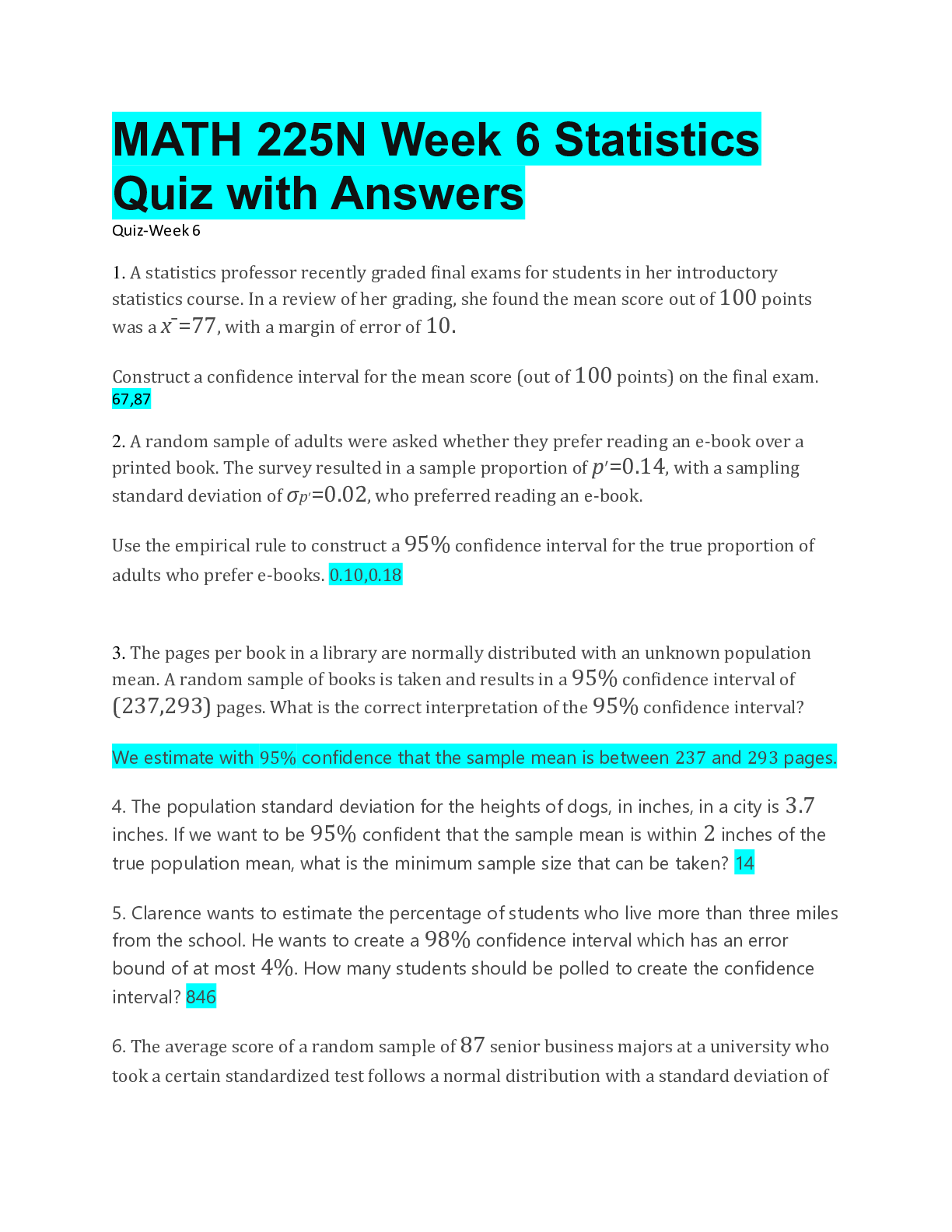

















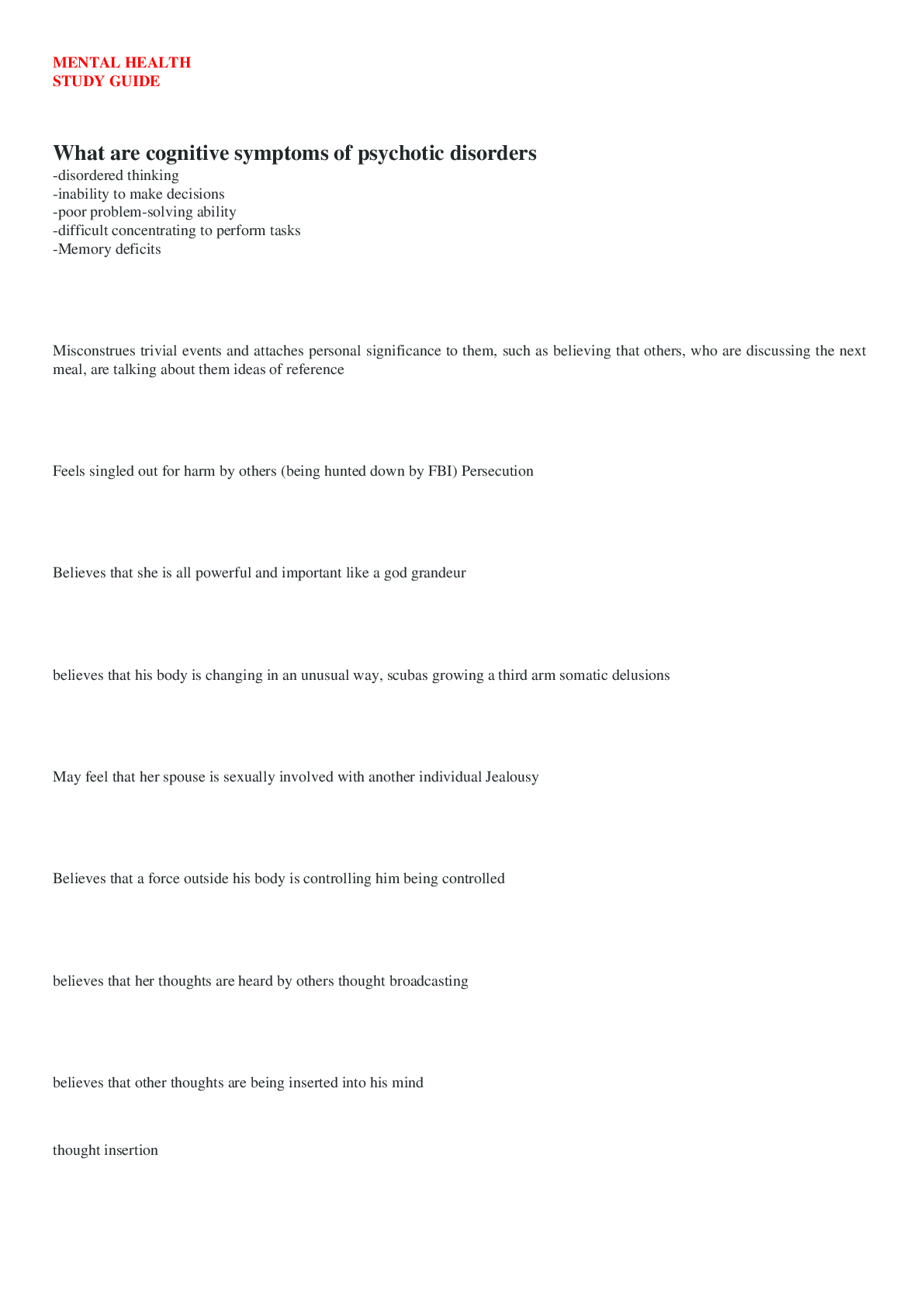
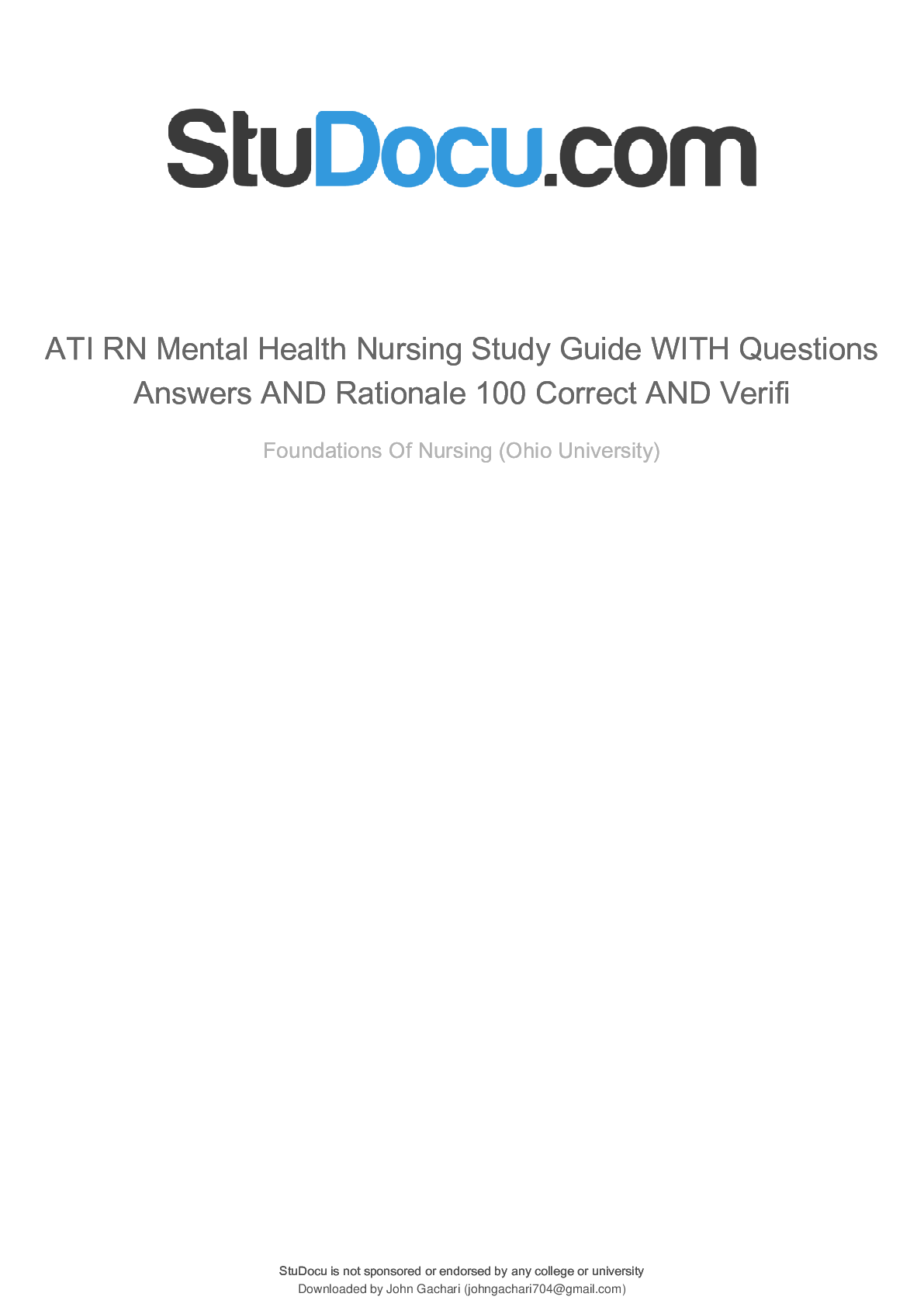
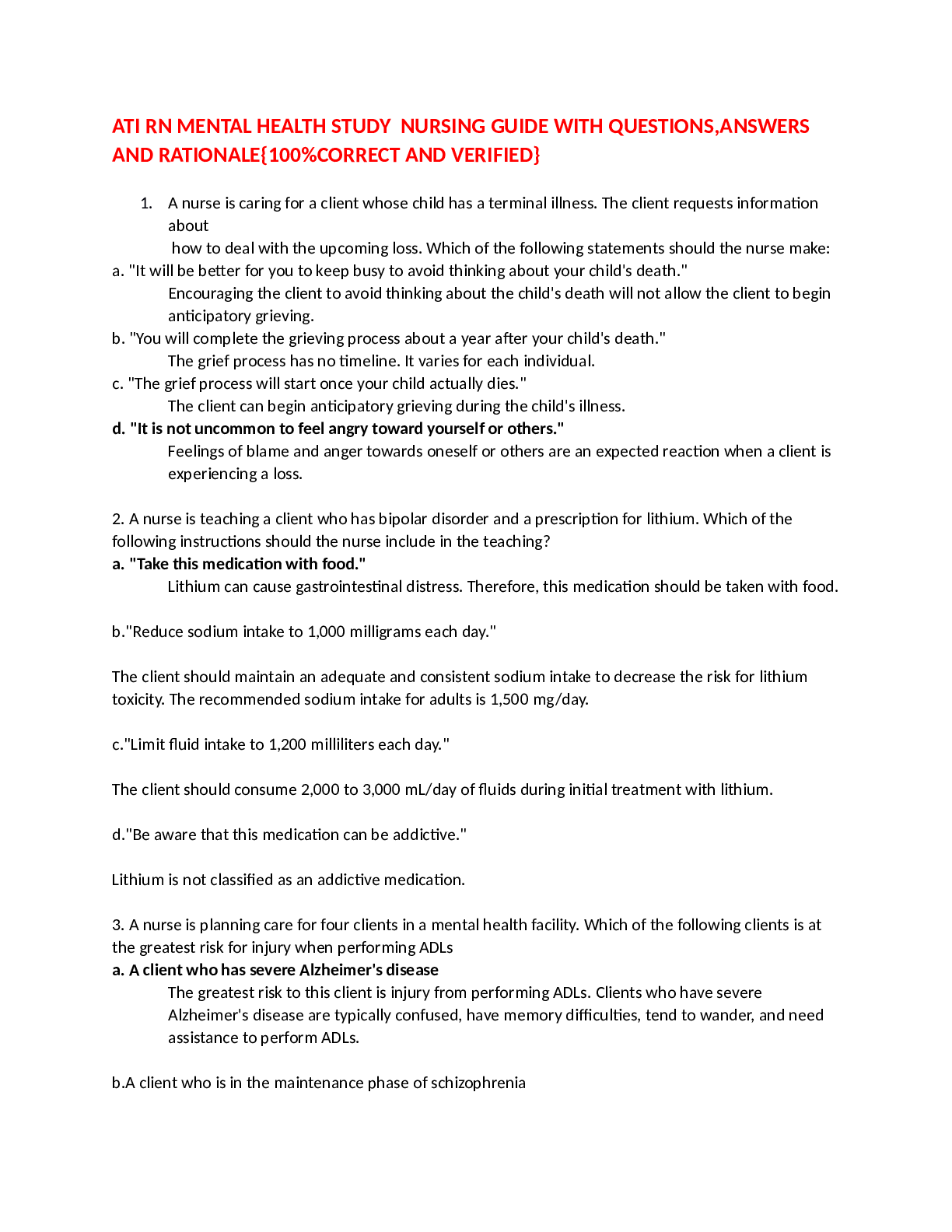
.png)
 – Chamberlain College of Nursing.png)

